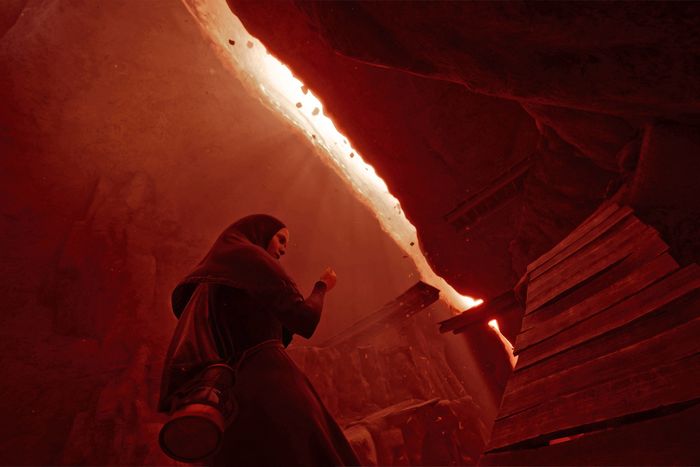
For a game about the rejection of mystical thinking, Indika is filled with no end of odd, phantasmic details. Take the scene of Holy Communion near its beginning: Indika, a young Russian Orthodox nun and our unconventional heroine, is waiting dutifully to take her sip of wine. But just before the sacrament reaches her, she spies a tiny woman clambering out of the approaching nun’s mouth. This impish figure scurries down the nun’s arm to disrupt the ceremony, causing Indika, who can scarcely believe her eyes, to lose her bearings and fall over. As the camera swivels manically around her, the youngster mutters apologetically, the other nuns gazing slack-jawed as she tries to put a lid on the hallucination.
Indika cannot wholly keep out these intrusive thoughts and visions, and that is part of the wretched fun in playing the game. Across the roughly five hours of this third-person adventure, one that whisks us through a painterly yet uncannily photorealistic version of nineteenth-century Russia, we feel the youngster’s mind being cleaved apart as she clashes with the dogmatic rules of her Christian faith. Sometimes this conflict occurs as an acerbic male voice-over, presumably the internal monologue of Indika herself. “Useless labor is the basis of spiritual development,” he says as we direct Indika to fetch eight buckets of water in the freezing cold. “Obedience is above fasting and prayers,” he jibes a moment later. At other times, we see monstrous phantasms and then, later, what must surely be the devil himself, scuttling like a spider toward the edge of the screen.
A lot of the time, Indika plays like an artful walking simulator, the genre that became popular in the 2010s with a string of interactively minimalist, slow, reflective titles such as Dear Esther and Firewatch. Our protagonist moves without the bounding, athletic gait of a superhero, hardly even picking up the pace when the “run” button is held down. Her head is often bowed forward, as if in a perpetually submissive pose to the world at large, occasionally biting her nails and silently gesturing the Hail Mary. This gives us time to soak up our dreamily impressionistic surroundings: the endless expanses of white snow; rickety wooden buildings that seem to rise unnaturally to the sky; a fish factory filled with cans so big they make Indika look the size of a tiny mouse.
Beyond exploration, spatial puzzles are how you primarily interact with the game, and these can sometimes rip the very fabric of the dissenting hero’s reality apart. In one section, she must escape a rocky enclave that has cracked across two different metaphysical planes. Toggling between them causes the sound and visuals to twist and writhe from reality itself, in which Indika incessantly murmurs prayers to herself, to a blood-red fantasy realm soundtracked by pounding electronic music and the torments of the devil.
Indika might be weird, but it is not inaccessibly weird, and in melding a kind of high-concept strangeness with utterly ravishing visuals, all without losing sight of a desire to entertain, the game evokes the output of indie film studio A24. The kind of words that fans use to describe its movies — eccentric, authentic, immersive — apply here. The eccentricities, like a deliberately useless leveling-up system in which you accrue not experience but belief, are seamlessly integrated. And its authenticity stems from creative director Dmitry Svetlov wrestling with his own faith as a teenager in a religious household in Moscow (and ultimately renouncing it).
As for immersiveness, Indika is filled with visual flourishes that pull you deeper into its realer-than-real fairy-tale world, from the deft motion capture of Indika herself to the convincing billowing of her veil. The camerawork also draws us inward, evoking a movie not made by A24 but that sits in a stylistically adjacent space to it: Darren Aronofsky’s Mother! Indika is similarly claustrophobic to Aronofsky’s divisive allegory: During interactive sections, in which you either walk and talk or solve puzzles, the camera hugs the young nun as it might in any other third-person video game. But when the gameplay breaks for cutscenes, it can get stiflingly close, giving us little else to look at except her bright, panicked eyes and eerily smooth skin. Elsewhere, the camera skews off at bizarre, voyeuristic angles, giving the strange dissociative feeling that we are simultaneously inside and outside of Indika’s head, which is perhaps exactly how she feels.
There is a feverish quality to Indika that is equally applicable to both the story and the game’s effect on the player. A fever is unpleasant yet necessary, a means of violently driving out infection. This is precisely what Indika is going through with the Christian Orthodox doctrine that she has long internalized and now fundamentally wants to be rid of. But a feverish quality also suggests a work of art that has crossed the blood-brain barrier and infected its audience. This is how it felt playing Indika, a game thrillingly committed to taking us into the subjective worldview of its quietly rebellious lead. Each element, including the exaggerated architecture that teems with unearthly detail and strangely loping electronic score, reinforces her own shaky perspective being reforged in real-time. One can only imagine what such a process would have actually been like for a teenage girl in nineteenth-century Russia, and the game hints at this reality with instances of sexual violence. Compared to the otherworldly presentation elsewhere, these scenes are rendered with a sober eye — grotty and unpleasant. However, beyond such moments, Indika is a mostly deviant, irreverent treat, reveling in the doubts of its young nun. Strap yourself in: Brace yourself for her awakening.

